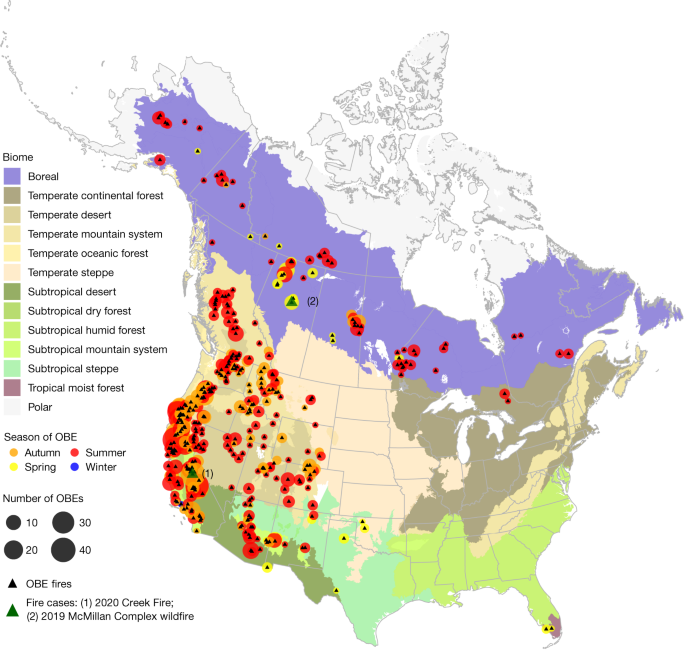Unveiling the Impact of Drought on Overnight Fires in North America
Belangrijkste concepten
The author argues that drought conditions are a significant factor in promoting overnight burning, challenging traditional fire management practices and the diurnal fire cycle model.
Samenvatting
Overnight fires in North America have been linked to drought conditions, with 99% of these events associated with large fires. The study found that accumulated fuel dryness due to drought led to consecutive overnight burning events, highlighting the need for early detection and management strategies. Additionally, there has been an observed increase in fire weather conditions conducive to overnight fires over recent decades.
Drought triggers and sustains overnight fires in North America - Nature
Statistieken
A total of 99% of OBEs were associated with large fires (>1,000 ha).
At least one OBE was identified in 20% of these large fires.
OBE frequency was positively correlated with fire size.
Daytime drought indicators can predict whether an OBE will occur the following night.
Citaten
"We demonstrate that drought conditions promote overnight burning, which is a key mechanism fostering large active fires."
"Although warming is weakening the climatological barrier to night-time fires, the main driver of recent OBEs in large fires was accumulated fuel dryness and availability."
Belangrijkste Inzichten Gedestilleerd Uit
by Kaiwei Luo,X... om www.nature.com 03-13-2024
https://www.nature.com/articles/s41586-024-07028-5
Diepere vragen
How can advancements in technology aid in the early detection and management of overnight fires
Advancements in technology can significantly aid in the early detection and management of overnight fires. For instance, geostationary satellite data can provide real-time monitoring of fire activity, allowing for quick identification of overnight burning events (OBEs). By utilizing this data, authorities can promptly deploy resources to contain fires before they escalate further during the night. Additionally, the use of terrestrial fire records combined with machine learning algorithms can help predict potential OBEs based on historical patterns and current environmental conditions. This proactive approach enabled by technological advancements enhances firefighting efforts and minimizes the impact of overnight fires.
What are some potential drawbacks or limitations of relying on daytime drought indicators to predict overnight burning events
While relying on daytime drought indicators to predict overnight burning events has its benefits, there are also potential drawbacks and limitations to consider. One limitation is that drought conditions may not always accurately reflect the actual fuel dryness at night when OBEs occur. Factors such as humidity levels or wind patterns during nighttime hours could influence fire behavior differently than during the day, leading to discrepancies between predicted OBEs and actual occurrences. Moreover, changes in weather patterns due to climate change could affect the reliability of daytime drought indicators over time, potentially reducing their effectiveness in forecasting overnight fires.
How might changes in land use impact the frequency and intensity of overnight fires
Changes in land use can have a significant impact on the frequency and intensity of overnight fires. Urban sprawl into wildland areas increases human-caused ignitions near forests or grasslands, elevating the risk of wildfires spreading throughout the night due to proximity to flammable vegetation. Furthermore, alterations in land cover through deforestation or agricultural practices can modify fuel availability and continuity within ecosystems, influencing how quickly fires spread during nighttime hours. As landscapes become more fragmented or degraded from human activities, there is a higher likelihood of larger and more frequent OBEs occurring as a result of changes in land use patterns exacerbating wildfire risks across North America's diverse environments.
0
